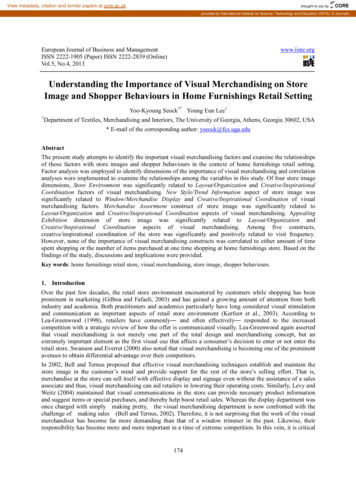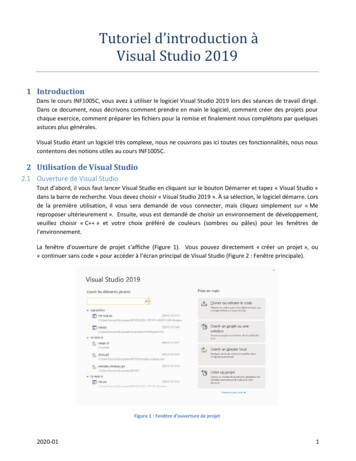
Transcription
View metadata, citation and similar papers at core.ac.ukbrought to you byCOREprovided by International Institute for Science, Technology and Education (IISTE): E-JournalsEuropean Journal of Business and ManagementISSN 2222-1905 (Paper) ISSN 2222-2839 (Online)Vol.5, No.4, 2013www.iiste.orgUnderstanding the Importance of Visual Merchandising on StoreImage and Shopper Behaviours in Home Furnishings Retail SettingYoo-Kyoung Seock1* Young Eun Lee11Department of Textiles, Merchandising and Interiors, The University of Georgia, Athens, Georgia 30602, USA* E-mail of the corresponding author: yseock@fcs.uga.eduAbstractThe present study attempts to identify the important visual merchandising factors and examine the relationshipsof those factors with store images and shopper behaviours in the context of home furnishings retail setting.Factor analysis was employed to identify dimensions of the importance of visual merchandising and correlationanalyses were implemented to examine the relationships among the variables in this study. Of four store imagedimensions, Store Environment was significantly related to Layout/Organization and Creative/InspirationalCoordination factors of visual merchandising. New Style/Trend Information aspect of store image wassignificantly related to Window/Merchandise Display and Creative/Inspirational Coordination of visualmerchandising factors. Merchandise Assortment construct of store image was significantly related toLayout/Organization and Creative/Inspirational Coordination aspects of visual merchandising. AppealingExhibition dimension of store image was significantly related to Layout/Organization andCreative/Inspirational Coordination aspects of visual merchandising. Among five constructs,creative/inspirational coordination of the store was significantly and positively related to visit frequency.However, none of the importance of visual merchandising constructs was correlated to either amount of timespent shopping or the number of items purchased at one time shopping at home furnishings store. Based on thefindings of the study, discussions and implications were provided.Key words: home furnishings retail store, visual merchandising, store image, shopper behaviours.1. IntroductionOver the past few decades, the retail store environment encountered by customers while shopping has beenprominent in marketing (Gilboa and Fafaeli, 2003) and has gained a growing amount of attention from bothindustry and academia. Both practitioners and academics particularly have long considered visual stimulationand communication as important aspects of retail store environment (Kerfoot et al., 2003). According toLea-Greenwood (1998), retailers have commonly― and often effectively― responded to the increasedcompetition with a strategic review of how the offer is communicated visually. Lea-Greenwood again assertedthat visual merchandising is not merely one part of the total design and merchandising concept, but anextremely important element as the first visual cue that affects a consumer’s decision to enter or not enter theretail store. Swanson and Everret (2000) also noted that visual merchandising is becoming one of the prominentavenues to obtain differential advantage over their competitors.In 2002, Bell and Ternus proposed that effective visual merchandising techniques establish and maintain thestore image in the customer’s mind and provide support for the rest of the store’s selling effort. That is,merchandise at the store can sell itself with effective display and signage even without the assistance of a salesassociate and thus, visual merchandising can aid retailers in lowering their operating costs. Similarly, Levy andWeitz (2004) maintained that visual communications in the store can provide necessary product informationand suggest items or special purchases, and thereby help boost retail sales. Whereas the display department wasonce charged with simply making pretty, the visual merchandising department is now confronted with thechallenge of making sales (Bell and Ternus, 2002). Therefore, it is not surprising that the work of the visualmerchandiser has become far more demanding than that of a window trimmer in the past. Likewise, theirresponsibility has become more and more important in a time of extreme competition. In this vein, it is critical174
European Journal of Business and ManagementISSN 2222-1905 (Paper) ISSN 2222-2839 (Online)Vol.5, No.4, 2013www.iiste.orgthat marketers understand consumers’ evaluation of visual merchandising aspects and its relationship with theirshopping behaviours.Consumers today tend to place considerable importance on the home as a place to live, relax, and enjoy lifewith their families – a reflection of the current lifestyle trend toward casual expression in fashionable homefurnishings as well as in apparel (Sloan, 2007). Today the inventory of home furnishings available to theconsumer seems almost endless, with well-designed home products including everything from kitchen items,such as pots, pans, and pepper mills, to items for the bedroom, such as bedding and blankets (Bell and Ternus,2002). However, the boundaries of both home furnishings and furniture retail industries have recently blurredas the home furnishings stores have carried furniture as well. For instance, the home furnishing stores such asPottery Barn, Crate and Barrel, West elm, Restoration Hardware, etc. have carried furniture as one of the majormerchandise. Hereby, consumers have been able to purchase furniture in the home furnishings stores. Asconsumers have placed more and more importance on their home (Forney et al., 2005), more attention hasbeen given to home furnishings retail setting, especially in industry literature; however, far too little attentionhas been paid to home furnishings retail setting in the academic literature stream. Thus, the current studyattempts to contribute to the academic literature by focusing specifically on examining the importance of visualmerchandising in home furnishings retail setting. The purpose of the present study is to identify the importantvisual merchandising factors and examine the relationships of those factors with store images and shopperbehaviours in the context of home furnishings retail setting. This study will provide home furnishings storeexecutives and managers in determining the ultimate visual merchandising components to create effective storeenvironments that affect positive shopper behaviours at home furnishings stores.2. Literature Review2.1 Visual Merchandising (VMD) and Store ImageVisual merchandising is the presentation of a store and its merchandise to the customer through the teamworkof the store’s advertising, display, special events, fashion coordination, and merchandising departments in orderto sell the goods and services offered by the store (Mills et al., 1995, p.1). In 1998, Pegler argued, Visualmerchandising is no longer just a matter of making merchandise look attractive for the customer. It is the actualselling of merchandise through a visual medium (p.1) . In addition, Bell and Ternus (2002) asserted thatvisual merchandising, once called ‘display,’ has evolved from its origins as a store’s decorative arts departmentto its current status as a sales-supportive entity, which impacts store design, store signing, departmentalmerchandise placement and display, store atmospherics, and store image (p.18). Visual merchandising istherefore concerned with both how the product and/or brand is visually communicated to the customer and alsowhether this message is decoded appropriately in the context affecting a positive psychological or behaviouraloutcome, ultimately leading to purchase (Kerfoot et al., 2003). According to Wright et al. (2006), atmosphericstimuli please the actual and emotional needs of consumers and enhance the degree of consumer participationin a store, leading to favourable purchasing behaviours. More recently, Law et al. (2010) also asserted thatvisual merchandising that covers the store exterior and interior that are involved in creating a favourableshopping atmosphere can enhances consumers’ perceived image of the store. The term visual merchandisingtends to be interchangeably used with the term display. Nevertheless, visual merchandising involves muchmore in terms of practices and responsibilities than simply displaying merchandise (Swanson and Everett,2000).According to Pegler (1998), visual merchandising involves a number of technical and artistic components:colour, texture, lighting, mannequins, fixture, graphics, signage and so on. Other researchers asserted that of allthe atmospheric cues, colour is the strongest motivator for shopping (Mills et al., 1995). Kerfoot et al. (2003)suggested that the use of a wide variety of colours is deemed to produce attractive and appealing display andhad the potential to positively impact on a respondent’s propensity to browse. Many researchers also haveconsidered lighting as one of the major contributing factors of visual merchandising in the retail setting (Belland Ternus, 2002; Berman and Evans, 2004; Levy and Weitz, 2004). More recently, Park and Farr’s research(2007) revealed that the colour quality of lighting in a retail store environment such as colour temperature and175
European Journal of Business and ManagementISSN 2222-1905 (Paper) ISSN 2222-2839 (Online)Vol.5, No.4, 2013www.iiste.orgcolour appearance affects consumers’ emotional states and the behavioural intention of approach-avoidance.Bell and Ternus (2002) further described the range of visual merchandising, such as window and interiordisplay, promotional signing, store layouts and interior décor, fixture layouts, displaying merchandise on wallsand fixtures. Window display, according to the findings of Lea-Greenwood (1998), is a vitally important visualcommunication tool used in retailing. Edwards and Shackley (1992) reported that sales increase when windowdisplays are used, particularly for new products, and well- known brands need effective elements of a windowdisplay. Similar to the previous research, Omar (1999) asserted that the careful selection of merchandise for thedisplay‒ items that are distinctive, timely, stylish, or particularly good value― contributes to the successful saleof those items. At the same time, the use of appropriate merchandise, careful choice of the right fixtures, andtastes and imagination in designing and executing the display contributes greatly to the overall store image.Signs are silent sales associates and are often the first contact that customers have with a store, adepartment, and the merchandise (Colborne, 1982). Signs provide important information which the customercan use in making purchase decisions (Mills et al., 1995); for example, effective signs identify departments,describe the merchandise and its price, inform customers of special sales events, alert customers to advertisedmerchandise, and determine the theme of special window and interior displays (Colborne, 1982). As furtherevidence of signage effects, Levy and Weitz (2004) claimed that sings as one of the visual communicationmedia help boost sales by providing information on products and suggesting items or special purchases. Morerecently, Cant, M.C. and Hefer, Y. (2012) also asserted that visual merchandising enhances store image andconsumer shopping experience at the store, adding value to the store character. They found, in particular, thatspatial orientation within the store and well-designed visual merchandising display affects consumers' perceptionon the retail store. Furthermore, results of their study indicated that consumers perceive visual merchandising asa promotional tool.As store environmental cues represent the most imperative channel through which retailers can communicatetheir images with consumers, it is critical to understand how consumers infer images from such environmentalcues. According to Dickson and MacLachlan (1990), consumers employ store image to determine how suitablethey are as customers for a particular store. Bell and Ternus (2002) suggested that effective visualmerchandising establishes and maintains the store’s physical and mental image in the consumers’ mind. Anumber of previous studies indicated that store atmospheric cues create the overall context within whichshoppers make purchase decisions and are likely to significantly impact shaping store image. However,surprisingly, there has been a lack of studies on how visual merchandising is related to the perception of storeimage, whereas many researchers have considered the visual aspects of store environment as one of thecomponents of store image. Therefore, the current study will address visual merchandising as a separatevariable in relation to the perception of store image.2.2 Visual Merchandising (VMD) and Shopper BehavioursRetail store atmospherics may impact shopper behaviour. According to Chain Store Age (2004), the majority ofconsumers (63%) remember occasions when the store atmosphere caused them to buy more or spend more timeat a store. Moreover, among those influenced by store atmosphere, almost half (45%) report that they spent notonly more money in the store but, more time. As noted in Turley and Milliman’s (2000) review on the effect ofatmospherics on consumer behaviour, the influence of store atmosphere on time spent in the store has receivedattention from researchers and, therefore, merits further discussion. Time spent in the store is related to thedesire to stay in or to get out of the store environment and is also related to the decision to shop or not to shopat the store (Kellaris and Altsech, 1992). In their landmark article introducing the Mehrabian-Russell (M-R)environmental psychology model to the study of store environment, Donovan and Rossiter (1982) suggestedthat store-induced pleasure plays a significant role as a determinant of approach-avoidance behaviour withinthe store, including spending behaviour, and that store-induced feelings of alertness and excitement could resultin increased time spent in the store. More than a decade later, Donovan et al. (1994) replicated and extended theDonovan and Rossiter’s study, confirming that pleasure engendered by store atmosphere contributes to extratime spent in the store and unplanned spending. In 2003, Babin et al. found that the combination of colours andlighting plays a critical role in influencing the purchase intention of consumers’ store patronage. Kouchekian176
European Journal of Business and ManagementISSN 2222-1905 (Paper) ISSN 2222-2839 (Online)Vol.5, No.4, 2013www.iiste.organd Gharibpoor (2012) found that store layout, color, lighting, store design, cleanliness and height of shelvesare the significant determinants of consumer buying decision at a grocery store.As such, despite the important role of visual merchandising in shaping shopper behaviours in the store, therehas been little discussion about visual store atmospheric cues relating to shopper behaviours in academicresearch. Rather, most of the research investigating the effects of store environment on time spent in the storefocused on musical atmospheric cues, such as types of music (Yalch and Spangenberg, 1990), loudness orvolume (Smith & Curnow, 1966) and tempo (Milliman, 1982), while a few of them focused on the olfactorycues of store atmosphere (Spangenberg et al., 1996). Hence, the current study will particularly identify thedimensionality of visual merchandising in terms of its relative importance evaluated by consumers in the homefurnishings retail setting and investigate its overall relationships with perception of store image and shoppingbehaviours in the home furnishing retail setting. From the previous literature on importance of visualmerchandising, store image, consumer shopping behaviours, the following research hypotheses wereformulated for the study.H1: There are multi-dimensions of the importance of visual merchandising in the home furnishings retailsetting.H2: There are multi-dimensions of the perception of store image in the home furnishings retail setting.H3: The importance of visual merchandising will be significantly related to the perception of store image in thehome furnishings retail setting.H4: The importance of visual merchandising will be significantly related to time spent shopping in the homefurnishings retail stores.H5: The importance of visual merchandising will be significantly related to store visit frequency in the homefurnishings retail stores.H6: The importance of visual merchandising will be significantly related to the number of items purchased inthe home furnishings retail stores.3. Research Methods3.1 Sample and Data CollectionA structured questionnaire was developed to collect data and distributed to a convenience sample of 600females, whose ages range from 25 to 55, residing in a South-eastern state of the United States. A conveniencesample included female consumers who have shopped in one or more home furnishings stores at least onceover the past year. In order to collect data, the researchers contacted various local organizations such as officesat a university campus, community organizations, churches, retail stores, and so forth. Of the six hundreds ofquestionnaires, 263 surveys were returned, indicating a return rate of 43.83 percent. After scrutinizing thereturned questionnaires, 70 among 263 questionnaires were discarded: 3 respondents did not provide thedemographic information, 2 were male respondents, 22 respondents have not shopped in home furnishingsstore(s) within the past year, and 43 participants returned incompletely answered questionnaires. As a result,only 193 questionnaires were usable and included in the data analysis, yielding a usage rate of 32.17 percent.Slightly over half of respondents were between the ages of 25 to 30 (50.80 %) and this age group encompassedthe largest proportion of the respondents, followed by the 31-40 age group (16.90 %). The next largest agegroup was the 41 to 50 group (13.00 %) and the over-50 age group was at 9.3 %. More than half (71.00 %) ofthe respondents were Caucasian, followed by Asian/Pacific islanders (16.10 %) and the rest of the race groupaccounted for less than 5 %. The income frequency revealed that 29.3 percent of the respondents reportedannual household incomes of less than 20,000 before taxes, while 23 percent reported annual householdincomes over 80,000.3.2 MeasurementThe questionnaire consisted of three sections. The first section consisted of two parts. The purpose of the firstpart was to screen out unqualified respondents who have not shopped in a home furnishings store over the pastyear. The second part comprising 25 items was designed to identify multi-dimensions of the importance of177
European Journal of Business and ManagementISSN 2222-1905 (Paper) ISSN 2222-2839 (Online)Vol.5, No.4, 2013www.iiste.orgvisual merchandising. The statements were adopted and modified from Spies, Hesse, and Loesch’s research(1997) conducted in two IKEA home furnishings stores. This part specifically concerned an evaluation of therelative importance of visual merchandising based on respondents’ shopping experiences in the homefurnishings stores. Requiring respondents to recall their shopping experiences in the home furnishings storeswhile they are participating in this survey, respondents were asked to assess the importance of visualmerchandising on a 5-point Likert-type scale, with 1 (not important at all) to 5 (very important).The second section was divided into three parts. The first part was to obtain information on the respondents’favourite home furnishings stores. Eight home furnishings stores were chosen in the area. Respondents couldselect one or more home furnishings stores as their favourite store(s); in addition, they had an opportunity toname their other favourite store(s) (other than the presented home furnishings stores) with another option,Others. The second part consisted of 13 statements was structured to elicit the perception of store image ofthe favourite home furnishings stores. The statements were adopted and modified from the previous research(Baker et al., 1994; Marzursky and Jacoby, 1986). Respondents were required to respond as to whether or notthey agree with each statement on their favourite stores. A 5-point Likert scale with 1 corresponding tostrongly disagree to 5 strongly agree , was used to measure responses to each statement in the questionnaire.The last part of the second section of the survey concerned consumer shopping behaviours at their favouritehome furnishings stores. Respondents were first asked how much time they stayed in the home furnishingsstore, while shopping in the home furnishings store in order to estimate the approximate actual shopping time.Five options are given with an interval of 30 minutes: less than 30 minutes, 30 minutes to less than 1 hour, 1hour to less than 1 and half hours, 1 and half hours to less than 2 hours, and 2 hours and more. Respondentswere also asked about store visit frequency and the number of items purchased at one time shopping at theirfavourite store. Lastly, in the third section of the survey, respondents’ demographic data was collected, such asage, gender, race, annual household income, and the number of people in household.A pilot test of the measurement instrument was requisite to validate the items and scales in the questionnaire.For the current study, the pilot test was based on 35 respondents. The 35 respondents were female consumers,whose ages range from 25 to 55 and were asked to not only complete the questionnaire but also point out anywording problems, unclear statements, and confusing instructions. As a result of the pilot test, two statementswere deleted in the first section because of confusing wording resulting in 25 items on the importance of visualmerchandising. Cronbach’s alpha value for the internal consistency aspect of reliability of the visualmerchandising measure was 0.84.4. Data Analysis and ResultsData gathered from the survey was analyzed using the Statistical Package for Social Science (SPSS) program.4.1 Factor Analysis of Visual Merchandising and Store ImageA principle component of factor analysis with varimax rotation was used to identify the underlying dimensionsof the importance of visual merchandising. Prior to conducting factor analysis, Bartlett’s test of sphericity andthe Kaiser-Meyer-Olkin (KMO) measure of sampling adequacy (MSA) was performed to determine whetherthe EFA was an appropriate statistical technique for this study. Only components with eigenvalues greater than1.0 and items with rotated factor loadings of 0.50 or greater were retained because factor loadings of 0.50 orgreater are considered statistically and practically significant (Hair et al., 1998). Furthermore, any item loadingon more than one factor with a loading score equal to or greater than 0.40 on each factor was discarded toconfirm that each factor would have only one dimension and that each attribute would load on only one factor(Chen and Hsu, 2001). Variables with communalities less than 0.40 were also omitted from the further analysisas the communality of a variable refers to the amount of variance accounted for by the variable in the factorsolution: Low communalities may mean insufficient contribution to explaining the variance. Lastly, factorsconsisting of only a single item were discarded as well.178
European Journal of Business and ManagementISSN 2222-1905 (Paper) ISSN 2222-2839 (Online)Vol.5, No.4, 2013www.iiste.orgThe Kaiser-Meyer-Olkin measure of sampling adequacy was 0.77 and the Bartlett’s test of sphericity wassignificant (X² 1982.43, 496, p 0.000), indicating the appropriateness of the factor analysis for the data onthe importance of visual merchandising. According to the aforementioned criteria for the factor analysis, 10 outof 25 items in the importance of visual merchandising scale did not meet the criteria as mentioned above andwere dropped for further analysis. After deleting those 10 items, the Cronbach’s alpha value was 0.77,indicating sufficient reliability. The results of the principal component analysis with varimax rotation yieldedfour underlying factors, accounting for 58.26 % of the total variance (See Table 1).A principle component of factor analysis with varimax rotation was used to identify the underlying dimensionsof the perception of store image in the home furnishings retail setting. The Kaiser-Meyer-Olkin measure ofsampling adequacy was 0.79 and the Bartlett’s test of sphericity was significant (X² 749.13, 105, p 0.000),indicating the appropriateness of the factor analysis for the data on the importance of visual merchandising. Thesame criteria with the factor analysis for the importance of visual merchandising were set. According to thecriteria for the factor analysis, 1 out of 12 items in the perception of store image scale was dropped and fourunderlying constructs emerged: Store Environment, New Style/ Trend Information, Merchandise Assortment,and Appealing Exhibition, explaining 68.14 % of the total variance (see Table 2). Cronbach’s alpha value forthe scale was 0.80.4.2 Correlations between Importance of Visual Merchandising and Store Image Constructs in the HomeFurnishings StoresCorrelation analyses were conducted to examine the relationship between four constructs of importance ofvisual merchandising and four store images dimensions (see Table 3). Of four store image dimensions, StoreEnvironment was significantly related to Layout/Organization (r .21, p .01) and Creative/InspirationalCoordination (r .25, p .01) factors of importance of visual merchandising; those who appreciated storeenvironment at their favourite home furnishings store placed significantly greater importance onlayout/organization and creative/inspirational coordination of the store than other factors of visualmerchandising. New Style/Trend Information aspect of store image was significantly related toWindow/Merchandise Display (r .33, p .001) and Creative/Inspirational Coordination (r .31, p .001) ofvisual merchandising factors; those who valued new style and trend information of their favourite store placedsignificantly greater importance on window/merchandise display and creative/inspirational coordination ofvisual merchandising factors. Merchandise Assortment construct of store image was significantly related toLayout/Organization (r .17, p .05) and Creative/Inspirational Coordination (r .19, p .05) aspects ofvisual merchandising; those who evaluated their favourite home furnishings stores offer good variety ofmerchandise assortment believed window/merchandise display and creative/inspirational coordination of visualmerchandising aspects are significantly more important than other aspects of visual merchandising. AppealingExhibition dimension of store image was significantly related to Layout/Organization (r .17, p .05) andCreative/Inspirational Coordination (r .23, p .01) aspects of visual merchandising; those who appreciateappealing exhibition of their favourite home furnishings store believed store layout/organization and creativeand inspirational coordination of visual merchandising aspects are significantly more important than othervisual merchandising factors.4.3 Correlations between Importance of Visual Merchandising and Shopper Behaviours in the HomeFurnishings StoresCorrelation analyses were conducted to examine the relationship between four constructs of importance ofvisual merchandising and consumer shopping behaviours in home furnishings retail setting (see Table 4).Consumer shopping behaviours in this study included the amount of time spent shopping in the store, visitfrequency and the number of items purchased at one time shopping at the store. None of the importance ofvisual merchandising constructs was correlated with time spent shopping in home furnishings stores. Amongfive constructs, creative/inspirational coordination of the store was significantly and positively related to visit179
European Journal of Business and ManagementISSN 2222-1905 (Paper) ISSN 2222-2839 (Online)Vol.5, No.4, 2013www.iiste.orgfrequency; those who visited the store more frequently placed greater importance of creative/inspirationalcoordination of the store (r .17, p .05). However, other constructs of the importance of visualmerchandising were not related to visit frequency. In addition, none of the importance of visual merchandisingconstructs was related to the number of items purchased at one time shopping at home furnishings store.5. Discussion and ImplicationsThe major thrust of the current study is to better understand the relationship of the importance of visualmerchandising and consumer shopping behaviours, specifically in the home furnishings retail setting. Twocharacteristics distinguish the current study from prior research on store environment-related topics. First,perhaps most important, is that this study addresses the importance of visual merchandising as the most crucialvariable for this study. Although marketing literature is replete with research on store environment in this area,visual merchandising was virtually unexplored in the extant literature. Second, the home furnishings retailsetting is of critical concern in the current study. As a result of the consumers’ ever-increasing interest in theirhomes as relaxed places, the home furnishings setting has been becoming one of the most focused areas in bothmarketing and retailing fields (Forney et al., 2005). However, the home furnishing retailing setting is still anundiscovered frontier in both fields. Accordingly, tackling both attributes of this study― the visualmerchandising and the home furnishings retailing setting― might be not only critical but painstaking task toaccomplish in this study; nevertheless, through various consecutive processes, the current study came to theconclusions that wi
Visual merchandising is the presentation of a store and its merchandise to the customer through the teamwork of the store's advertising, display, special events, fashion coordination, and merchandising departments in order . and well- known brands need effective elements of a window display. Similar to the previous research, Omar (1999 .











